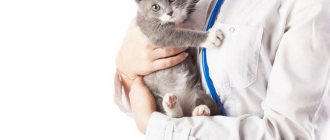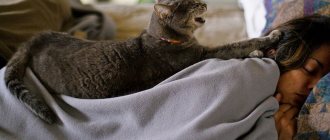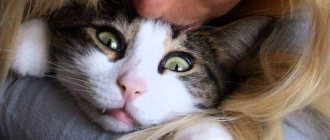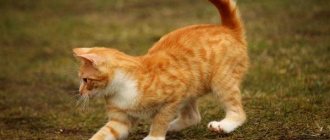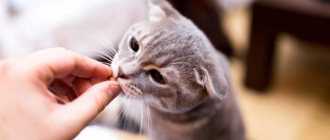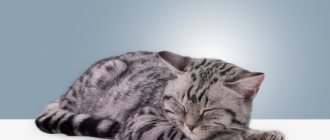Everyone knows that purrs are smart creatures. They are on their own, even though they are fawning. In most cases, they simply beg for food and, accordingly, are very selfish. However, there are also individuals for whom human attention is very important.
They are not afraid and calmly make contact. Although you shouldn’t always trust people, because they can offend you. It especially hurts when they grab the tail. It is easier to catch the beast with it. Some non-humans not only pull, but also lift the poor animal by this part of the body.
The meaning of the tail in the life of cats
To understand the dangers of pulling a cat's tail, it is important to understand the basic functions of this part of the body. It is necessary for a full-fledged cat’s existence and performs the following tasks:
- serves as a balance regulator when jumping and moving in height;
- if you fall, it helps you “steer out” and fall straight on your paws, avoiding injury;
- is a means of communication: through movements of the tail, the cat communicates with its relatives and expresses its emotions towards its owners.
There are breeds whose standard implies a short tail or almost no tail. For example, tailless Manxes have 2–3 tail vertebrae (while most breeds have 20–27).
These cats have more developed hind limbs, which partly compensate for their natural taillessness. If an animal loses its tail in adulthood, its motor and communication functions will be impaired.
A little psychology: the system of signs and self-expression in behavior
Having lived with a cat even for a short time, you can learn to understand it - the animal gives a number of signals that allow you to determine its condition and well-being. There is a whole system of signs that help the domestic predator express itself:
- experiencing a feeling of fear, the cat bends down to the ground and presses its ears tightly to its head, showing a clear desire to hide in a secluded place; if the fear is especially strong, then the manifestations are brighter - dilated pupils, raised fur;
- aggression in its pure manifestation is more noticeable in males: they look at the enemy, prick up their ears, cower, tilting their heads slightly to the side, lean forward to prevent the opponent’s attack; females most often show aggression, protecting their offspring - they attack quickly and unexpectedly, threatening, cats hiss, opening their mouths wide and exposing their teeth;
- tactile whiskers on the face can indicate the mood of the cat: for example, if they are tense and directed forward, then the pet is interested in something, and if they are pressed to the cheeks, then the cat is either aggressive or calm and relaxed;
- when a cat hunts, it presses its front to the ground, tenses its body, being ready for a sharp jump, tilts its ears slightly forward and looks intently at its target;
- the cat also gives vocal signals: by its intonation, the owner will be able to recognize an insistent request (frequent long meow), greeting (short sound), resentment (choked and drawn-out exclamation), hunger or complaint (usually a loud guttural sound);
- one of the most pleasant cat manifestations in communication is purring - if a cat honors you with such a sound, then you definitely deserve it - she enjoys communication, is relaxed or grateful for something.
Cats are one of the most popular pets. They are elegant and amaze with their variety of appearance. There are many features in the structure and functioning of their body, including the ability to see in poor lighting and hide their claws.
Spine part
Cat owners know how carefully their pets treat their own tail, protecting it from careless touches of guests and household members. And this is no coincidence, because the tail contains many nerve endings necessary for the normal functioning of the animal.
Even the slightest injury in this area causes unbearable pain to the pet. For this reason alone, for caring owners, the answer to the question of whether it is possible to pull a cat’s tail is obvious.
In addition, it should be borne in mind that the tail is an extension of the spine. It consists of individual vertebrae that are connected to each other by cartilage and joints that provide mobility.
The first 5–8 caudal vertebrae are absolutely identical in structure to the elements of the main parts of the spine (that is, they have a body and an arch); in the remaining parts there is no spinal canal.
It is necessary to pay attention to the fact that cats are not docked for aesthetic purposes, like dogs. Any damage to this area compromises the functioning of the animal's nervous system. The health consequences can be quite serious, including complete loss of sensation in the back of the body.
Are the attacks sudden?
If we do not consider cases when a cat bites a child because he unknowingly causes her pain, such a situation can be prevented or at least smoothed out. To do this, you don’t even need to spend a long time figuring out why the cat bites when you pet him. It’s enough to simply monitor how the purr’s behavior changes. Animals demonstrate everything very clearly; they do not know how to hide emotions under masks.
Turn your attention to the cat and see how it changes when you run your hand over its back or tummy. When the animal receives pleasure, it stretches and luxuriates under your hands, purrs, becomes relaxed, as if flowing.
Otherwise, all the muscles of the body are grouped, as if in a moment of danger. The ears are flattened, the pupils dilate, the skin twitches in the areas of stroking, and tail flapping is observed. Further caresses in this case are inappropriate; you urgently need to leave the purr alone.
If you pull a cat's tail, it may "shit"
In search of an answer to the question of what will happen if a cat is pulled by the tail, many have probably come across the popular belief that the animal will then begin to “shit anywhere.” You shouldn’t brush this off as ridiculous superstitions about empty buckets and haircuts during pregnancy.
In this case, the conclusion of “collective intelligence” has good grounds. As mentioned above, the tail is part of the spine, and damage to the spinal column can cause complete or partial paralysis of the lower extremities, fecal and urinary incontinence.
If your cat was regularly subjected to unceremonious treatment by members of the household, and then suddenly began to relieve himself outside of specially designated places, you should not be angry with him, much less punish him. Perhaps these are the consequences of a spinal injury resulting from a sharp tug on the tail.
Mistake #2. Nipping “bad” habits in the bud
Remember that for animals, as for people, the rule works: you cannot get rid of a bad habit, you can only replace it with a useful one. Only in the case of a cat, its habits are often based on instincts that cannot be removed from the equation.
It is important to respect your cat's needs and allow her to do what she needs. The owner’s task is to change the direction of the habit in a direction where it will no longer have a negative impact
For example, if your cat sharpens her claws on furniture, give her a scratching post and teach her to use it. In fact, the action will be the same, but not a single sofa will be harmed.
Read more: “Scratchy paws. How to stop a cat from spoiling things?
When should you contact a veterinarian?
Serious damage to the tail is usually visible to the naked eye. You should seek veterinary help if your pet has the following symptoms:
- visible break or break in the tail area;
- painful reaction to touch;
- the tail is hot and inflamed, there is severe swelling;
- problems with the hind limbs, loss of balance, gait disturbance;
- the animal is unable to support its tail, it hangs like a whip;
- loss of previously formed neatness skills: involuntary defecation or urination.
Why do you need a haircut?
Grooming cats, unlike grooming six dogs, is more of a hygienic and preventive nature than aesthetic, and here's why.
- Cats with long hair tolerate heat less well and there is a danger of overheating.
- Cats with long hair are more likely to develop mats.
- The functioning of the digestive tract may be disrupted due to the large amount of hair in the stomach.
Owners of pets with long and semi-long hair cite the formation of tangles as the most common problem. The animal is not able to get rid of dense lumps on its own. Felt-like lumps form close to the skin. Cutting mats takes several hours and is a traumatic process for both the animal and the owner. It is difficult to carry out such a procedure with scissors; you will need a special tool - a tangle cutter. The question of the beauty of a haircut in such a situation does not even arise.
There is another unpleasant outcome associated with tangles and the hot period of the year. Many owners take their pets outside the city in the summer.
When mats form, the cat tries to lick the fur itself and begins to bite the mats. At the same time, it can damage the skin. The resulting wounds can be used by flies to lay their eggs. The result for the cat will be very sad.
There are model cat haircuts, which are carried out mainly before exhibition events. With this procedure, some imperfections in coat growth are “polished” to give a flawless appearance.
Some cat owners turn to beauty salons for smaller cats even for a hygienic haircut. However, not all cats can calmly tolerate the sound and vibration of a special machine, especially the touch of a stranger.
What clippers and trimmers are needed to care for a cat's claws and what is their price?
Some members of the feline family also panic during transportation, and in such cases, the use of sedatives is not a necessity, but an obligation.
Injury Prevention
As you know, any disease is easier to prevent than to treat. Therefore, in conclusion, let’s talk about preventive measures.
- Be careful when handling the animal. If you need to catch him, don't grab his tail - it's dangerous!
- Limit your pet's access to the street. If you have a private home, equip heavy doors with a soft-closing mechanism.
- Explain clearly to children and other family members why it is wrong to pull a cat's tail, using arguments appropriate to their level of understanding.
- If the baby is very small, do not leave the cat alone with him: this can be dangerous not only for the pet, but also for the child himself.
And remember, we are responsible for those we have tamed. Develop in children love and compassion for all living things from an early age - this will make them more responsible and happy!
Displace Anger
A child cannot resist an adult who is angry with him and punishes him from time to time. And here is the four-legged extreme one, whom the baby perceives as lower in rank than himself in the family hierarchy. “By offending an animal, a child can thus take out the irritation and anger that he experiences towards his parents,” warns Tatyana Mizinova. − Children often literally repeat the words and actions of adults. A child painted on the wallpaper and as punishment he was scolded and put in a corner. In the same way, a cat will receive a paw from a child, to whom the mother’s message is conveyed: “What have you done, tear off your hands!” In addition, a small child has magical thinking: he believes in a fairy tale where Little Red Riding Hood was eaten and then taken out of the wolf’s belly, so he does not see anything irreparable in the threat to tear off his hands. If mom wanted to do this with him, then why can’t she do the same with the cat’s paws?”
Read also: Why don't people like me?
Any conflict with a child must be resolved to the end, without leaving the little person alone with painful resentment, and after a quarrel, you must make peace. Sometimes it’s worth apologizing for being too hot. The child should have the right to express any feelings, including negative ones, but it is important to explain that the next time he wants to punish someone, he can play this with any toy. And most importantly, the baby should not lose confidence: no matter what happens, he is always loved by you.
Caution - rabies
If the cat is free-range, its behavior must be observed especially carefully. On the street there is a high risk of contracting various infectious diseases, many of which are fatal.
Having noticed a twitching of the tail and back of a freedom-loving cat, the owner needs to sound the alarm and find out why this is happening. These symptoms are often used to identify rabies. This disease is dangerous for both the pet and its owner. It threatens irreversible damage to the spinal cord and brain. In addition to the fact that the animal begins to twitch its tail and back, there are other signs of rabies:
- the cat eats food but refuses to drink water;
- the animal becomes aggressive or, conversely, tries to hide from people;
- have difficulty swallowing food;
- saliva is produced profusely;
- the pet begins to constantly bite itself at the place through which the infection entered the cat’s body.
But whatever the symptoms, only a veterinarian can accurately answer the question of why the cat is twitching its tail. However, if rabies is confirmed, the animal will have to be euthanized.
Nonverbal Communication
This is another answer why a cat bites a petting hand. When you first touch your pet, he may like these caresses. However, at some point the monotonous movements begin to irritate. The animal cannot tell you “Enough”, “Don’t press so hard”, but its dissatisfaction begins to grow. Therefore, she uses the channels available to her. If the owner is unable to understand that the purr is experiencing discomfort, then the culmination will be a bite. The best solution would be to stop after a few minutes of petting. If the animal is determined for further contact, it will definitely demand continuation. Otherwise, he will calmly go about smoothing his fur coat.
What does it mean to pull bagpipes?
PULL BAGPIPE - who is talking about what? Start a long and boring conversation. It is implied that who l. tends to have long conversations, regardless of their importance or necessity. This means that a person, a group of people (X) only takes up time from the interlocutor... ...
Interesting materials:
What is on the Temple Mount? What is on the site of Cherkizon? What is on the Kremlin's Spasskaya Tower? What's next to the Czech Republic? What is on top, the numerator or the denominator? What does the discovery of the Higgs boson tell us? What is written on Mamayev Kurgan? What is written on the sword Excalibur? What to write about yourself on Instagram examples? What to write about yourself in an administrator's resume?
Is it possible to give a cat smoked, salted fish or river fish with bones?
The answer is: neither the first, nor the second, nor the third. And that's why:
Smoked food is very difficult for our four-legged pets. Once in the animal's body, it has a detrimental effect on the liver. Carcinogens formed as a result of processing such fish lead to the development of tumors and destroy the gastric mucosa.
If you want to offer your cat a piece of herring, think twice. The more salts in the product, the higher the risk of developing urolithiasis. Another danger that awaits tailed lovers of herring, salmon and pink salmon is opisthorchiasis, which we have already described above. So to the question, can cats eat salted fish? There is only one answer: no.
Bones injure the larynx and esophagus with intestines. Previously, we examined in detail the dangers of skeletal parts entering the animal's body and were convinced that in the worst case, immediate surgical intervention may be required.
Some people manage to feed their cats raw fish without realizing why this should not be done. We remind you once again: a product that has not undergone heat treatment is rich in parasites - there is a high risk of helminthic infestation.
Another argument against is the high content of histamine, which enhances allergic reactions and can provoke a significant deterioration of the condition during serious inflammatory processes. So if you know that your animal is sensitive to all natural food, it is better to switch it to special dry food so as not to risk it.
First aid
A pet's hanging tail is the first sign that any disease is beginning. It may be associated with a nervous disorder or be a harbinger of physical illness. Neglected treatment or its absence will lead to complications and deterioration of the cat’s health.
If your cat has a drooping tail, then first you need to feel it from the base of the tail to the tip. A cat’s painful reaction to touch signals the onset of the disease. A veterinarian will provide effective assistance, and you should try to determine whether the tip of the tail is broken or whether there are any wounds. In case of a fracture, a tight bandage is applied, and if scratches are noticeable, then the wound needs to be treated. Also, one of the reasons for this ailment is nerve rupture. The presence of a gap is determined by inspection of the tail.
If it does not move entirely, but, for example, only at the base and tip, and the middle reaches towards the floor and is in a hanging state, then this diagnosis will be confirmed. Also, do not forget about the emotional trauma of your pet. In the event of the loss of a beloved owner or the loss of offspring, he will be in a state of stress
At such moments it is especially important to show your love and care, otherwise the cat’s tail will droop and body disorders may begin.
Natural causes of cannibalism
cannibalism among domestic cats is more likely an accident, from which, however, we cannot be insured
It's more of a coincidence. From which, however, we are not immune. Among them, it is worth highlighting the killing of a kitten by a mother cat in her sleep.
Cats are extremely kind and caring towards their own and sometimes other people’s offspring, but misfortunes do happen: cases when a cat carelessly strangles kittens with her body in a dream do occur. Accidents include murder by eating placenta
After giving birth, the mother cat is extremely exhausted and exhausted. Feeling that there are life-giving substances in the placenta, cats often eat the placenta after the birth of the next kitten. It happens that a cat eats its newborn along with her. The fact is that it is not always possible to gnaw the umbilical cord without harming the kitten; as a result, the newborn may receive injuries incompatible with life. By the way, this is one of the reasons why owners need to be present during the birth of their pet and keep everything under control. From random reasons, let's move on to natural ones, in other words, why a cat can deliberately kill a kitten.
The kitten was born sick or dead
The cause of cannibalism among cats may be a natural instinct
- The kitten has congenital anomalies;
- The kitten was born sick or physically underdeveloped;
- A newborn with a cat mother has a different Rh factor of the blood, in this case the kitten is in mortal danger and without the intervention of the animal’s owners the kitten most likely will not survive;
- The cat ate a newborn who died of natural causes.
In the latter case, the cause of cannibalism was a natural instinct. Just like the placenta, it is a source of nutrients for her. Cats are not people; they do not tend to mourn the loss of their offspring. The same applies to nursing underdeveloped and weak kittens. A mother cat will not nurse such as humans would. If a cat sees that a newborn will not survive, it is more likely to kill it than to allow it to suffer and suffer, delaying the inevitable. This is the essence of natural selection. If you have witnessed a cat biting a kitten to death after giving birth, perhaps you shouldn’t be shocked; it’s just that she instinctively understands better than you who will live and grow up healthy and strong, and who was doomed from the very beginning.
Exhaustion of the cat
As we figured out, a mother cat can accurately “diagnose” her offspring, and she herself determines which babies she can feed for sure, so that the strongest representatives of the cat can survive and continue the cat family
After all, it is extremely important that hereditary defects and diseases are not passed on to future generations. But that's not the only reason
Hunger can extremely rarely cause cannibalism in cats, but such cases have been recorded. If a cat eats other people's kittens, in addition to extreme exhaustion, it may be driven by a feeling of competition or jealousy. There are practically no described cases of hunger as a cause of cannibalism towards their offspring in domestic cats. But if you do witness your cat eating her kitten, the first step is to isolate the remaining kittens in a safe, warm and dry place. Take measures to calm the mother cat, possibly even using tranquilizers. However, no later than 24 hours later, return the kittens to the cat so that the babies can eat their mother’s colostrum.
Numerous litter
the large number of litters cannot be a reason for cannibalism among domestic cats
There are no mentions of such cases among domestic cats, but for wild nature this is normal. The reason is banal: cats are trying to help their offspring survive, given a large litter and a lack of food, the cat is forced to make a selection. In terms of food, the cat leaves the strongest and most physically fit kittens, and eats the weakest ones. Thus, the survival of the fittest occurs and the aforementioned natural selection occurs. Just as in the case of domestic cats, wild kittens are often born with severe defects, stillborn or dying immediately after birth; the mother cat also eats such kittens so as not to leave them for scavenger animals.


